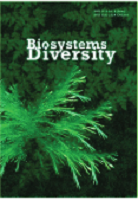Urban park layers: Spatial variation in plant community structure
Urban park layers: Spatial variation in plant community structure
Author(s): O. M. Kunakh, I. A. Ivanko, K. K. Holoborodko, O. I. Lisovets, A. M. Volkova, O. V. ZhukovSubject(s): Environmental Geography, Human Ecology, Environmental interactions
Published by: Дніпропетровський національний університет імені Олеся Гончара
Keywords: GIS-technology; human ecology; ecological monitoring; spatial ecology; vegetation indexes; urban ecology;
Summary/Abstract: Horizontal structure of natural plant communities attracted the attention of researchers for a long time, while the problem of horizontal structure of urban park plantations was not studied sufficiently. Species richness of different tiers of park plantation in the large industrial city of Dnipro (Ukraine) was revealed in this study. Also features of variation in the structure of plant communities at different spatial levels were revealed, the influence of park plantation canopy on the understory and herbaceous layer of the park. There were 30 plant species in the tree layer of the park plantation. The most common species were Robinia pseudoacacia L., Acer platanoides L., A. negundo L., Gleditsia triacanthos L., Aesculus hippocastanum L., Populus carolinensis Moench. The variance-to-mean ratio revealed that 13 tree species were randomly distributed throughout the park, and 14 species were aggregated. The number of occurrences of a given tree species per site and variance-to-mean ratio were positively correlated. The numerous tree species showed a tendency of aggregated distribution within the park. Sixteen plant species were found in the understory. Among them, the most abundant species were Acer platanoides L., A. negundo L., A. pseudoplatanus L., Sambucus nigra L., Robinia pseudoacacia L. Eight species were found to be randomly distributed over the park area, and eight species showed an aggregate distribution. The number of species encountered in the understory and variance-to-mean ratio were positively correlated. In the herbaceous stand, 99 plant species were found, of which Chelidonium majus L., Viola odorata L., Impatiens parviflora DC., Parthenocissus quinquefolia (L.) Planch., Geum urbanum L. predominated. The variance-to-mean ratio of all species was significantly less than unity, indicating regular spatial distribution. The values of alpha- and gamma-diversity of the plant community in separate layers are very different. The highest gamma diversity was found for the herbaceous stand, while the diversity of the tree stand and understory was significantly lower. Alpha biodiversity of the tree stand and the understory did not practically differ. Beta diversity values between the layers are very close, and beta diversity is practically equal for tree stand and herbaceous layer. Thus, we can assume that the mechanisms of species turnover for the plant communities of different layers are determined by the common causes. The spatial broad-scale component was able to explain 8.2% of community variation, the medium-scale component was able to explain 4.2% of community variation, and the fine-scale component was able to explain 0.7% of community variation. The understory is the most sensitive to the environmental factors, the herbaceous stand is somewhat less sensitive, and the tree stand is the least sensitive to the environmental factors. The environmental factors in this study are represented by a set of variables. The spatial variation of the stand is predominantly influenced by the factors of trophicity and moisture of the edaphotope. These same factors also act on the herbaceous stand and understory, but along with them are included the environmental variables, which are determined by the architectonics of the crown space and thus the light regime, which is regulated by the tree stand. It is important to note that the variation of the communities of the different layers of the park plantation is subject to spatial patterns. The herbaceous and understory variation is more spatially structured than the tree stand variation. The spatial patterns can arise as a result of the influence of spatially structured environmental factors and as a result of factors of a neutral nature. The latter aspect of variation is best described by the pure spatial component of community variation.
Journal: Biosystems Diversity
- Issue Year: 30/2022
- Issue No: 3
- Page Range: 274-288
- Page Count: 15
- Language: English

